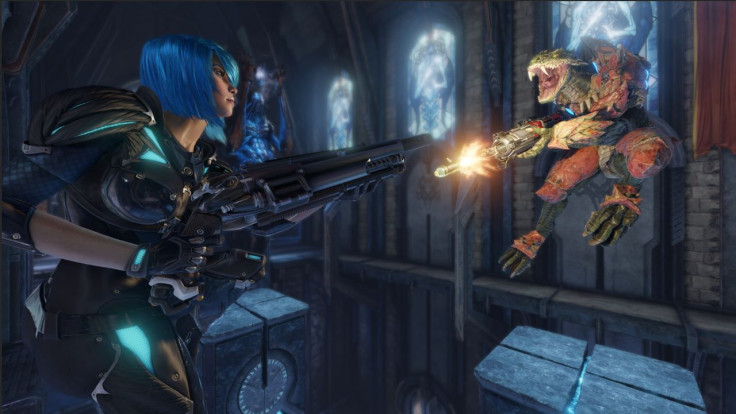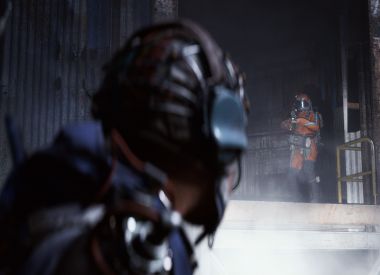Quake Champions is one step closer to its free-to-play debut, following its transition from a closed beta on Bethesda’s network to a paid beta in Steam’s Early Access program. And although we got to play the Quake Champions Early Access build over the weekend, We’re still not convinced that a new focus on hero-specific abilities will be enough for the Quake franchise to stay competitive in a world obsessed with Overwatch, League of Legends or Dota 2.
Quake Champions isn’t just old Quake with a new label. You’ll find some of the same ingredients in the new recipe, but Champions is discernibly different from previous additions to the series. Players can choose from 11 different heroes, each with a unique ability, and swap between them as needed after dying. Abilities vary, from Visor’s Piercing Sight (which lets you see through walls) to Galena’s Unholy Totem (a healing totem and proximity mine), and can be used to get kills, escape deadly situations or lay traps for your opponents.
The current build has four match types: Deathmatch, Duels, Sacrifice and Team Deathmatch. The first and last mentions in that list should be familiar – the first dropping eight players into a free-for-all, while the latter pits teams of four against one another. The goal, in both scenarios, is to get more kills (and, ideally, die fewer times) than your adversaries. Duels, which are one-on-one battles, are also pretty self-explanatory. Finally, the only new addition is Sacrifice, a four-on-four competitive mode that combines aspects of Control Point and Capture the Flag matches. It’s also intended to be the go-to match type for Quake Champions esports events.
The usual free-to-play hooks are also present (or will be at launch). The only way to get in right now is to buy the Champions Pack. But a free-to-play version will have a rotating pool of heroes and let players purchase their favorites individually. Quake Champions has three in-game currencies, two earned by playing and one that can only be purchased to spend on cosmetic items and loot boxes. Boxes come in three tiers – backpacks, chests and reliquaries – with drops of varying rarity. Backpacks are the easiest to earn and hold new runes (hero-specific challenges), armor shaders and cosmetic items. Chests and reliquaries only bestow shaders and cosmetics, the former offering two random drops while the latter holds three. Avatars for your Quake Champions profile also drop sporadically.
The game tries to straddle the divide between traditional competitive shooters, which emphasize quick reflexes and precise aim, and the many teamwork-oriented games (from Dota 2 to Overwatch) that dominate the current competitive landscape. Quake Champions’ lack of aim assist both lends to its old-school credentials and has a perceivable impact on the community’s tactics. Less-skilled players tend to rely on a handful of firearms, mostly lightning guns and rocket launchers, that require less precision to get kills and it also means fights tend to break out more frequently at those weapons’ spawn points.
Hero abilities also impact the flow of each match, but their impact tends to vary based on a number of factors, including the layout of the current map, the hero whose ability has been activated and the skill of the player using that ability. Some, like Nyx’s Ghost Shift, will prove to be more of an irritant – they make it easy for targets to escape death – than a threat. But others, like Scalebearer’s charge or Galena’s totem, can be extremely deadly in the right hands (and circumstances). Match types can also impact the usefulness of some abilities. Sorlag’s Acid Spit, which damages on impact and continues to deal injure the target for a short period, is great for stealing kills in Deathmatch. Each ability is useful in the right situation, but a handful of heroes (mostly just Doomslayer) are emerging as early favorites in the Quake Champions community. What’s more, the player score gap between first and last place in each match is usually pretty wide.
Despite the big changes made to Quake Champions, the biggest obstacle is attracting new players. We’ve yet to see the game crack Steam’s list of the 100 most popular games on the platform right now. And while no one expects the shooter to do PUBG numbers right out of the gate, it has to be discouraging for the dev team to see Quake Champions pull in fewer than 3K concurrent players.
The lack of excitement isn’t shocking. We were curious when Bethesda and id Software announced a new addition to the Quake franchise, but we’ve largely been disappointed with Champions so far. The game’s roster is relatively small when compared to popular hero shooters and the abilities don’t add anything to the Quake formula that we couldn’t live without. Loot sounded interesting when id Software Creative Director Tim Willits discussed the prospect with Player.One at QuakeCon 2016, but Quake is played at a pace that makes it hard to appreciate cosmetic changes and the game’s first-person perspective means you almost never see your own gear. Both problems heavily diminish the value of loot boxes. Customization isn’t mandatory, but drops are arguably one of the top draws for anyone who isn’t satiating a 20-year Quake addiction.
Another big problem is that Quake Champions doesn’t know what it wants to be. The game is much faster than Titanfall 2 or Battlefield 1, but it still feels less chaotic than any recent Call of Duty. What’s more, the extra layer of depth the abilities bring to team-based modes don’t compare to the strategies seen in Overwatch.
We’re also not fond of the 60-second warm-ups at the start of each match. Most modern competitive titles let players futz around in Practice/AI mode while they wait for matchmaking servers to find a game. Extending the length of every round by ten percent for mandatory practice seems unnecessary. Some networking tweaks would probably help too. It’s difficult to stay competitive in a match if your ping climbs much higher than 50-75ms.
Quake Champions is an interesting take on a Quake -style shooter. But there doesn’t seem to be much of a demand for that anymore. Still, the game isn’t dead in the water. It may not be attracting huge audiences, but we’ve run into enough players with higher than average profile levels for it to be clear the game is finding a niche. And id Software’s willingness to spend large sums of money on the competitive scene guarantees some level of interest for the foreseeable future. Whether that crowd continues to grow, before or after the free-to-play version of Quake Champions debuts, remains to be seen.
Quake Champions is available in Early Access. There’s still no timeline for the free-to-play version of id Software’s latest competitive shooter.
Be sure to check back with Player.One and follow Scott on Twitter for more Quake Champions news in 2017 and however long id Software supports Quake Champions in the years ahead.


















